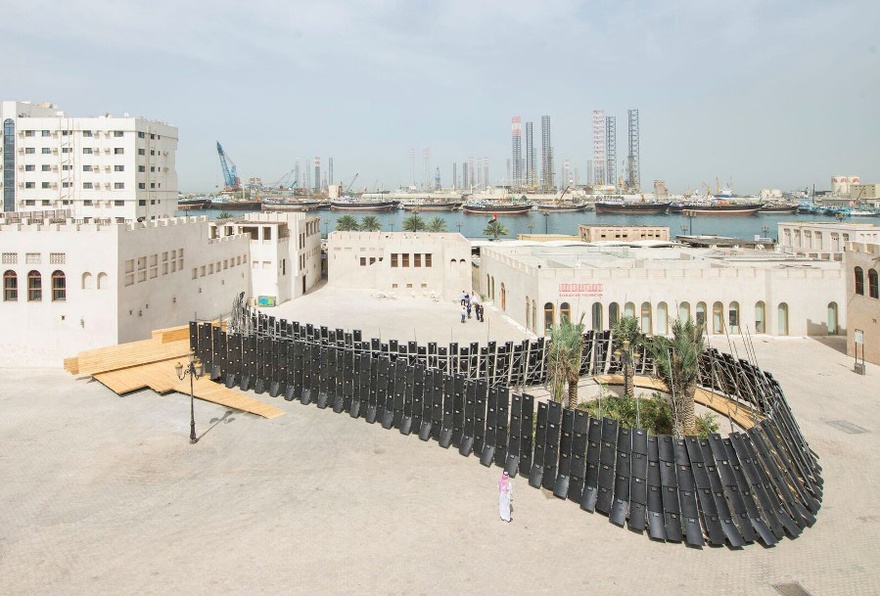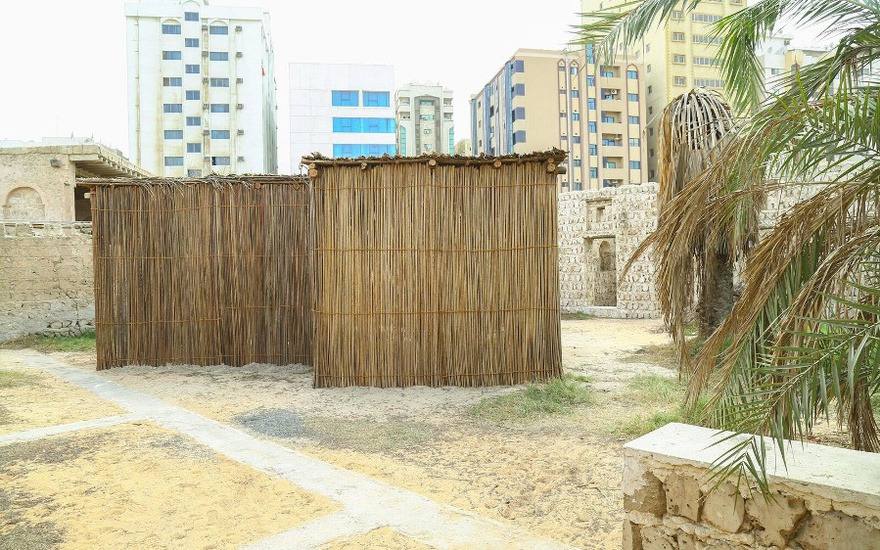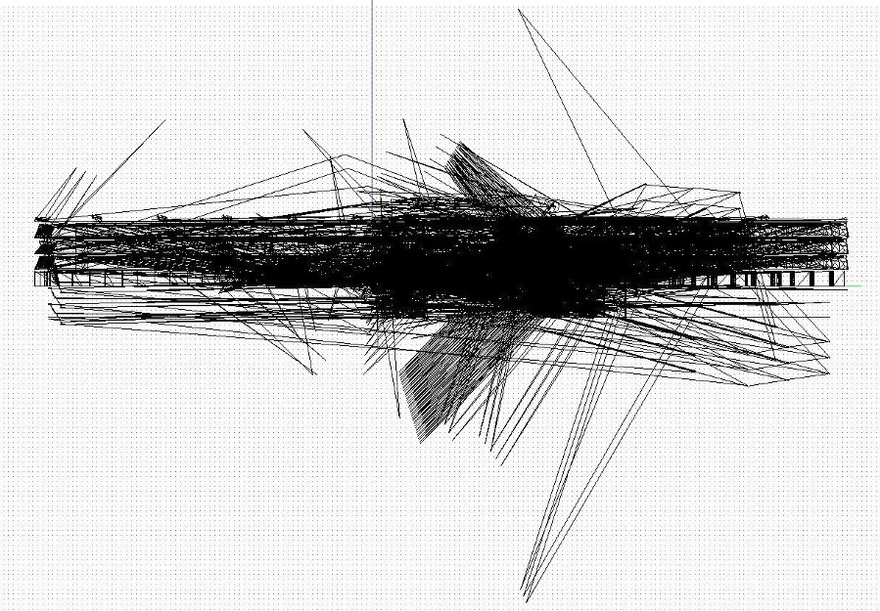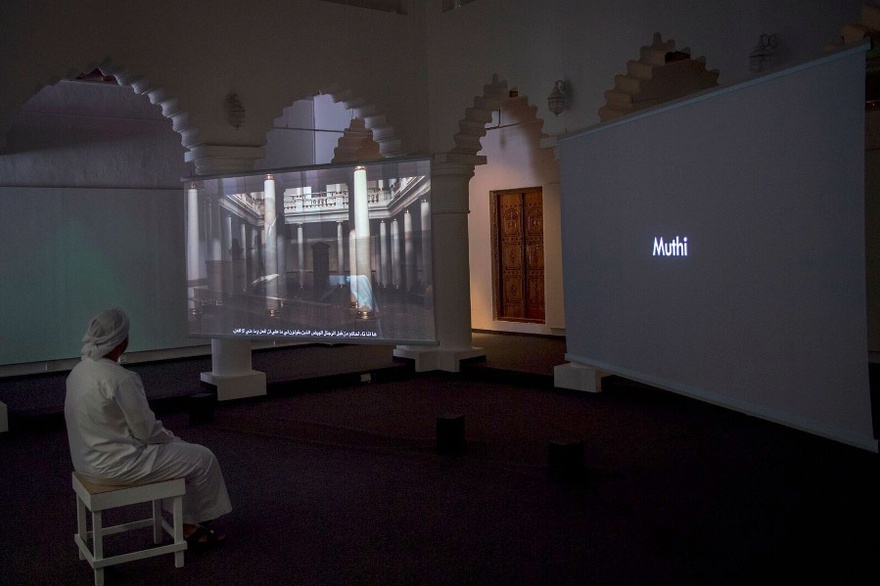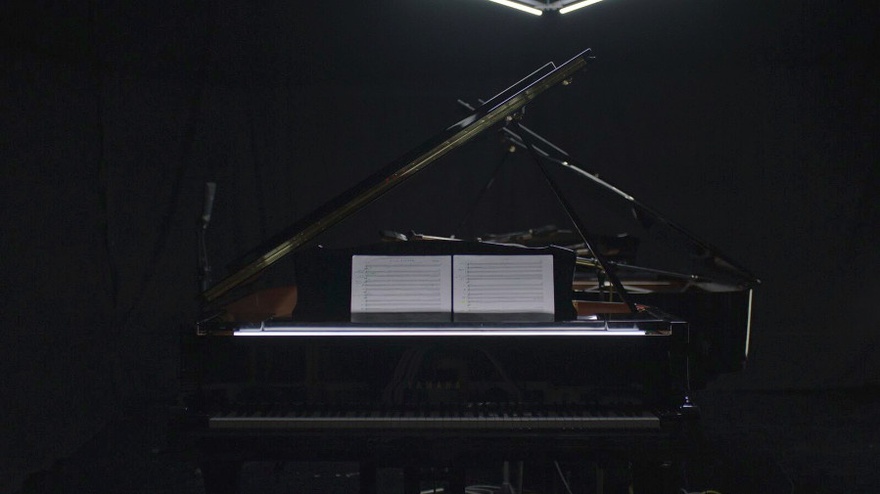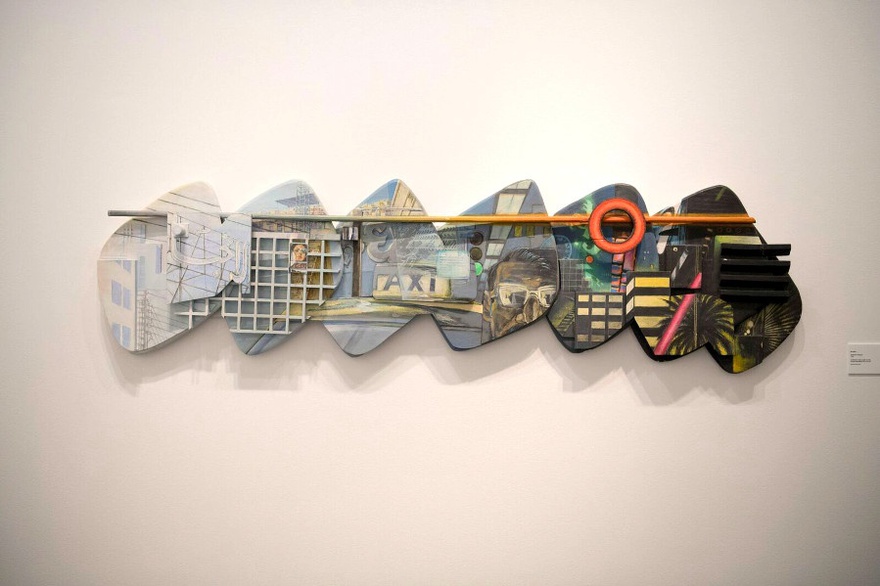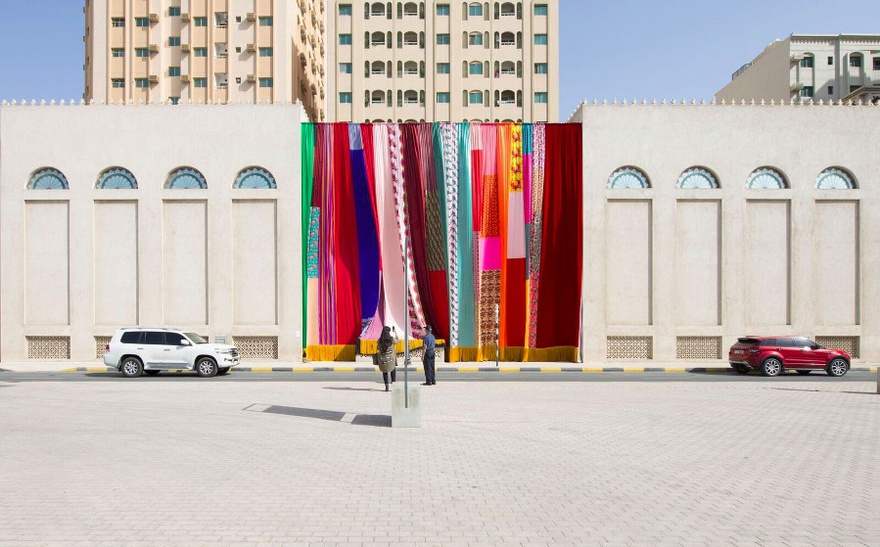Reviews
Act I: Sharjah Biennial 13
'There are two ways to lose oneself: walled segregation in the particular or dilution in the universal.'
– Aime Cesaire quoted by Salah Hassan at the 2012 March Meeting
A narrative trajectory has unfolded through each edition of the Sharjah Biennial since Yuko Hasegawa curated SB11 in 2013 using the Islamic courtyard garden as a metaphor for the context at hand. That context was Sharjah after the 2011 Arab uprisings and the controversy surrounding the removal of a work from SB10 that year; a situation that drew (predominantly western) accusations of censorship while highlighting the distance between the Biennial and its local audience. In response, Hasegawa's Re:Emerge – Towards a New Cultural Cartography realigned Sharjah's position by locating it within the 'Global South', a reframing whose purpose appeared twofold. It drew links with Sharjah's community, representative of the MENASA region, while also reminding a western audience of where Sharjah is located, geographically and culturally. The garden was an apt motif: it connected the cultures of the non-western world while articulating the conditions in which visitors entered the Biennial space – as guests invited into a sovereign site constructed for knowledge production and exchange.
SB11 was followed by Eungie Joo's 2015 edition, The past, the present, the possible, which was rooted to the context of Sharjah by site-specific commissions (over two thirds of works by fifty-one participating artists and groups), and a curatorial focus on Sharjah's 'future history' as 'written through urban development, heritage-site restoration, interdependent transnational economies and a diverse everyday culture'. The frame, then, contracted after Hasegawa's expansive vision – or rather, it recentred. The idea, it seemed, was to consider how the Sharjah Art Foundation (SAF, which runs the Sharjah Biennial) might move forward not only after a period of change in the MENA and the world at large, but after having taken stock of Sharjah's local, national, regional and global positions. (The following year, SAF staged a number of ambitious international endeavours, such as The Time is Out of Joint, curated by Tarek Abou El Fetouh and organized with the Asia Culture Center in Gwangju, placing Joo's Sharjah-focused SB12 within the broader context of SAF's activities.)
Cue the 2017 Sharjah Biennial (SB13), Tamawuj, curated by Ashkal Alwan founder Christine Tohme, who seems to have united the geopolitical and institutional concerns of the Sharjah Biennial's previous two editions in order to, as the curatorial statement explains, 'mobilise ongoing conversations'. This thematic expansion has been articulated both conceptually and physically, with SB13 taking place across Sharjah, Beirut, Dakar, Ramallah and Istanbul between October 2016 and October 2017, with the help of four interlocutors, Kader Attia, Lara Khaldi, Zeynep Oz, and Ashkal Alwan. SB13 launched in October 2016 with the SB13 School, a yearlong educational programme in Sharjah, a publishing platform (www.tamawuj.org), and a digital research platform titled chip-ship, described as a 'digital storage space' that connects each context in which the Biennial is operating. The first offsite project, Vive l'Indépendance de l'Eau, happened in January 2017: a two-day event of symposia, performances and workshops organized by Kader Attia focusing on the politics of water in the twenty-first century. On 10 March 2017, Act I of SB13's exhibition opened in Sharjah (running to 12 June 2017), with some 70 participating artists and 32 new commissions. Act II will open in Beirut on 19 October 2017, with offsite projects unfolding in Beirut, Istanbul, and Ramallah in between.
Act I of Tamawuj offers a galvanizing point of departure from the Sharjah Biennial's recent past while also paying homage to it. One obvious connection to Hasegawa's edition is evidenced in the dramatic installation in the space between the Sharjah Art Museum and Bait Al Serkal, where Eric Chen and Rain Wu's Collectivism (2016) – a wall of 600 police riot shields curving around a small garden of indigenous plants – recalls SB11's concept of the garden as a protected sovereign space. Other garden-inspired works include Hind Mezaina's Dubai Gardens (2017), a series of cyanotypes of plants found in gardens around Dubai paired with texts by architect Todd Reisz, in which a city of spectacle is portrayed through its interstitial green spaces; and Tonico Lemos Auad's A Moment of the Sky / Four Humours (2016/17), which features a collection of medicinal desert plants growing in octagonal shapes on the floor, with an empty section within the structure representing banned species. These pieces offer a subtle curatorial nod to a moment that has moved at once into the past and toward the future, in which the optimism surrounding the emergence of a new Global South in a decolonized post-western world has given way to hardening borders and laws, global divisions, and geopolitical shifts. Indeed, Oscar Murillo's site-specific disruption of the Bait Al Serkal courtyard – which has effectively been torn apart with bricks removed from the floor, stacked elsewhere, and holes dug in – rips up the courtyard metaphor completely, as reflected in the work's title: Condiciones Aún Por Titular, Conditions Not Yet Known.
In this regard, SB13's curatorial interest in 'cultivating collaborations, infrastructures and strategies' reflects a different kind of cartographical project that feels both urgent and overdue. As Tohme states, 'Tamawuj will pose questions around, and propose answers to, the conditions for the possibility of an art world'. The possibility of an art world in times like these is an interesting place to begin when taking into account the Sharjah Biennial's history, with Tohme creating a frame in which works are relieved of a geographical concept – be it the Global South or Sharjah itself – so that ideas might expand into a world beyond that which has been mapped.
This leap into the void is where the exhibition's title, Tamawuj, comes in, whose translations include: 'a rising and falling in waves', 'a flowing, swelling, surging, or fluctuation', and 'a wavy, undulating appearance, outline, or form'. Act I embodies the many facets of this title on multiple levels, with Mario Garcia Torres' Five Feet High and Rising, an SB13-commissioned work, exemplifying the curatorial approach. Located in the ruin of Bait Al Aboudi, an audio lecture plays inside a straw shack housing images of rivers, from postcards to paintings. The lecture illustrates a meandering study of the river as symbol in movies and songs from popular culture, including Justin Timberlake's 'Cry me a River', Dennis Lehane's novel Mystic River, and Boney M's cover of 'Rivers of Babylon'. 'The myth of the river has become a vessel that moves subsequent thoughts from place to place,' Torres notes in the recording, citing the world's 30 Black Rivers as exemplary, located anywhere from Jamaica to Ukraine. For Torres, the river is a conduit through which to think about 'metaphors ... desires, and what we want things to become'. These concerns align perfectly with Tohme's treatment of the artworks in Tamawuj: as metaphors left open to be whatever they need to be, both for and among themselves and for those who come to view them.
Some of the strongest works are audio-visual, with key pieces dispersed throughout the exhibition's locations like points in an affective cartography. At Calligraphy Square, Lawrence Abu Hamdan's sound work Saydnaya (the missing 19db) (2017) investigates the difference in sound levels before and after the 2011 Syrian revolution in Saydnaya prison, north of Damascus, where speaking aloud is punishable by death. Findings from this meticulous investigation is presented in a dark room where both care and severity hang in a harrowing balance, palpable in the artist's collaboration with former prisoners from whom he extracts traumatic memories recalled not through sight, but by sound. Such complex, affective, and searingly political mediations, in which the senses exist not in isolation but in active conjunction, occur throughout Tamawuj: most notably in The Otolith Group's Third Part of the Third Measure (2017), a thrilling two-channel audiovisual experience at Al Hamriya Art Centre, of musical compositions performed by four pianists on two pianos composed by militant Black composer Julius Eastman, presented as 'an experience of watching in the key of listening'.
Sensory and affective potency is evident, too, in Jonathas de Andrade's O Peixe [The Fish] (2016), a 16mm film transferred to 2K video shown in Calligraphy Square. Fishermen from north-eastern Brazil are filmed holding a fish they have caught in their arms – hands stroking scales, cheek to gill – as each life ends. Projected onto a full wall, the work is visually stunning, despite this being an animal snuff film. Beauty and profound cruelty are thus contained in a frame where life and death, power and struggle, survival and natural law exist all at once, as four worlds collide: the fisherman, the fish, the viewer, and nature. These dynamics are echoed in Ursula Biemann and Paulo Tavares' installation Forest Law (2014) at Al Hamriya, in which video interviews with indigenous leaders from the Ecuadorian rainforest are shown alongside a conversation with Michel Serres about his book The Natural Contract (1990). In the video, Serres describes Goya's painting Fight with Cudgels (1820–23): two men fighting knee deep in quicksand, unaware the ground is swallowing them up. For Serres, the 'profound lesson' in the work is that while three people are engaged in the image (the two fighters and the viewer), there is a fourth witness we often forget: the living world. It is this world that Tamawuj implores we connect with as bodies that form – what Serres calls – a natural force acting both with and against it.
Nature thus becomes a limitless and vital metaphor in Tamawuj, manifesting in several works, from Allora & Calzadilla's The Great Silence (2014), in which a story by Ted Chiang imagines how the Amazona vittata parrots might narrate their own extinction, to Em'Kal Eyongakpa's Rustle 2.0 (2016), an installation at Al Hamriya in which sound recordings from the Amazon and Congo Basin are interpreted by LED lights that flash across a dark room covered in plant fibres. In Rustle 2.0, nature is bound with technology; a bond also illustrated in Kader Attia's Mimesis as Resistance (2013), in which an excerpt from a David Attenborough documentary focuses on the Australian lyre bird's ability to mimic any sound, including that of roughly twenty other birds species, and the sounds of human activity, from a camera shutter to a car alarm and chainsaw. In Metahaven's video Information Skies (2016), presented at the Sharjah Art Foundation's Art Spaces, this binding is brought into the realm of human existence, in a moving work that combines live film, animation and digital overlay to create a narrative about a world where 'the weight of the soul' is 'measured in terabytes'.
This reality – in which the singularity looms as a future threat, potentiality, and/or inevitability – is proposed as a context within which agency might (or must) be extracted in Noise (back-broadcast through the persistent illusion (2017), presented at Al Hamriya by the collective A.S.T. The multimedia installation consists of animations and written texts shown on multiple screens; it is based on a collaboration with architect and scholar Keller Easterling, among others, to create what is essentially a manifesto recognizing the complexity of infrastructure as an invisible, omnipresent force that constitutes an organic and technological form to which all bodies are bound. Thinking back to Forest Law, we return to the concept of humanity as a force of nature and the idea that, while one world expects union with technology, there is another that continues to fight for a human relationship with nature itself. Then there is the world that exists in the space between, which is the kind of space Tamawuj seeks out. Take Marianna Castillo Deball's Hypothesis of a Tree (2016): a giant bamboo spiral-shaped mobile with 56 outer branches on which rubbings of fossil sediments made on Japanese paper hang. The work is a response to the conflicting theories of time between palaeontology – 'the territory of tangible fossils' – 'and the very ethereal and cybernetic study of genetic data', which Deball sought to reconcile by bringing the two worlds together.
Throughout Act I of Tamawuj, then, the intertwining of threads with threads emerges as a hallmark of a curatorial approach that favours transformative fluidity over solid form. Christodoulos Panagiotou's Untitled (2017) presents jewellery in one room at Bait Al Serkal, with each piece featuring a pseudomorph: a mineral pretending to be another. James Webb's Threnody (2016) at Al Hamriya consists of an audio recording in which vocalist Zami Mdingi performs the reversed vocals from The Beatles' 1968 track 'Helter Skelter', as interpreted with ethnomusicologist Cara Stacey. Ali Jabri, represented by a suite of collages at the Calligraphy Museum (including nine incredible box assemblages made between 1989 and 1992), offers (some very late-nineties era-esque) cross-hatching worldviews (from the eyes of a Buddha to the Egyptian pyramids) in 12 seasonally colour-coded collages. The crossovers inscribed into such compositions are far from harmonious, and by no means simplisitc. Taking post-colonial/neo-global hybridity as an ongoing negotiation is Fehras Publishing's installation Soapy Postmodern Bathwater (2017), which explores bilingualism in writings surrounding art and visual culture in the MENA region and its diaspora, while Uriel Orlow's two-channel video The Crown Against Mafavuke (2016) details a 1940s trial in South Africa of a healer accused of blending traditional and western medicine by those on either side of the cultural line.
Changeability, appropriation, inter-connectivity, contradiction, and multilectic interaction are thus all pinned to how SB13's title – 'wave' or tamawuj – has been interpreted: as a layered, continuous and ever-growing techno-organic flow of ideas and concepts that are graspable, expansive, familiar, other, grounded, universal, conflicting and mediatory all at once. This offers a way to both read and move between a set of diverse practices and contexts without falling into reductive frames, while interpreting the exhibition's collective expressions alongside the state the world is in today: at the cusp (or in the full throes) of climatic disaster and geopolitical upheaval driven by the violent and divisive processes of capitalist modernity that have shaped it since the first world maps – as we have come to know them – were drawn. The position feels decisive. After working with local potentialities, regional relations and geo-historical legacies, Tohme has taken the Sharjah Biennial into the realm of the global in dynamic yet grounded terms, untethered by geographic anchors aside from the network of various places within SB13's remit, whose connections are being enacted rather than symbolized.
On that note, it is fitting that Tohme placed Joe Namy's dramatic curtain made up of fabrics sourced from the nearby souk and created with local tailors in some kind of relation with Eric Chen and Rain Wu's public installation Collectivism. Titled Libretto-o-o: A Curtain Design in the Bright Sunshine Heavy with Love (2017), the curtain billows from the wall of the Sharjah Art Museum like a bright and beautiful flame in the face of Collectivism's severe expression of collectivity – that is, a wall protecting indigenous organisms created from an item associated with the hard violence of state security. Between a vibrantly clashing patchwork of flowing fabrics and a strong wall built to protect what is inside there must be a balance, or a way through.

